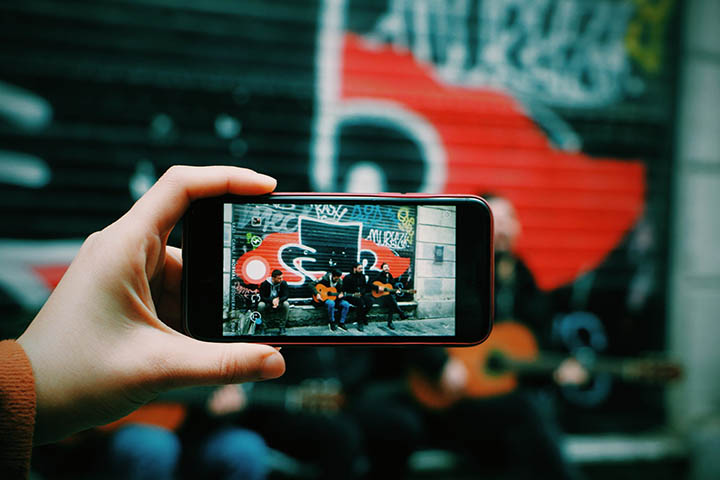The History of Photography

The History of Photography
The beginnings and evolution of photographic art Today, photography, an artistic discipline practiced by many, is available to everyone thanks to the many digital devices available.
Before perfecting in photography, it may be interesting to delve into the history of this particular art.
Through the history of photography, students can discover new techniques and study the evolution of photography over the years.
Let’s take a brief tour of the history of photography! Discover also our complete guide for the beginner photographer.
The beginnings of photography Although it was invented during the 1830s, it will be a few years before the art of photography is finally recognized by the public.
Dark room Photography
The History of Photography: To treat the photo in post production, the photographer used a dark room, a process that is still used today for long exposure, especially in analog photography.
The dark room and its mechanism, called camera obscure in Latin, actually existed since the fourteenth century. However, it was frowned upon to use this process, since the great painters of the time thought that the development of photography would end the noble art of painting on canvas.
The machine used by the photographer was far from resembling our current SLR camera!
This great machine was reserved for an elite who wanted to create more precise images than the paintings. Today, we find the same type of process in the animation industry through drawing in Retro Scope (which is present in old Walt Disney movies, for example).
The photograph through the camera obscure (or darkroom) hardly went unnoticed. The photographer had to carry a kind of large box in which he hid to take a picture of his model.
Famous Photos
This process was so frowned upon that Giovanni Battista, its inventor, was arrested and sentenced for witchcraft, since the nobility did not understand the function of this mysterious portable room.
In short, it was very difficult to be a photographer before the 19th century!
Do you also want to meet the most important photographers in history?
The invention of the first chamber and the daguerreotype Photography is a French invention.
The first famous photograph was taken by the inventor Joseph Niepce in 1826, and shows a simple view, immortalized from a window in a French town. The photo itself is not recognized for its aesthetic qualities, but for its innovation that has become a reference for expert photographers.
The lack of photographic technique can be seen at a glance in this image. Joseph Niepce had to expose his camera for more than 8 hours through the window. That is why we can see the sun both east and west of the building!
At that time, the inventors were quite capable of projecting images, but did not know how to preserve and conserve light. At his death, Joseph Niepce left his unfinished work to Louis Daguerre, an indisputable figure in photographic art.
The daguerreotype quickly became a recognized technique that gave rise to famous works such as: The artist’s workshop, Louis Daguerre,
Boulevard du Temple, Louis Daguerre,
Robert Cornelius, of himself (self-portrait),
The moon, John William Draper,
The official portrait of Abraham Lincoln,
The first press image (1847),
The solar eclipse sequence, William Langenheim and Frederick Langenheim, The portrait of Joseph Jenkins Roberts, Augustus Washington.
Photographic Techniques
The daguerreotype technique, started by Joseph Niepce and finished by Louis Daguerre, quickly became a hit among photography enthusiasts. Louis Daguerre even patented his invention in Britain, and everyone who wanted to make a daguerreotype had to pay a large sum of money to his inventor.
Over the years, other inventors put their grain of sand: we can mention, for example, William Henry Fox and his famous calotype, an improvement of the classic daguerreotype.
Finally, the British Frederick Scott Archer developed the principle of wet collodion to fix the emulsion in the glass. The inventor, however, abandoned his first invention to concentrate on the development of the negative role.
Discover also the advantages of webcam photography classes.

Photography Courses
To book your first photography course in Barcelona, do not hesitate to register on our Super Prof page.
The beginning of the 20th century and the spread of photography
During the years after Louis Daguerre’s invention, artists were not yet ready to accept photography as an art in itself.
It will be necessary to wait until the Universal Exhibition of Paris of 1859 so that the photographs and the classic arts (sculpture, painting, engraving) are exposed side by side. The commercialization of the first Kodak camera in 1888 also helped make photography accessible to the middle class. But it was in the twentieth century when photography met its true height!
Scientists found a particular interest in the art of photography. In fact, photographers had the opportunity to document with great precision the important events of political, cultural or scientific life thanks to their photographs. The photo was able to compete with the human eye, immortalizing moments too short for the individual.
During World War I, photography and technology in general became vectors of progress and change in society. The avant-garde artists combined technology and history by photographing the trenches, but also the daily life of ordinary people.
After World War I, photography became a means to immortalize changes in society and the reconstruction of the people during the period between the two wars.
It was during this period when photographic journalism arises, a popular art among photographers who want to make their passion their profession.
Photographers
During the first half of the twentieth century, photographers took pictures of the first trains, the construction of industries and factories, the development of urban centers or the circulation of cars for the working class.
Photography turned around populations around the world who saw with different eyes the changes in the society of the modern era. Finally, the color photo began to become popular during the 1930s, decades after the successful research of August and Louis Lumière.
Also take a look at our article on the best resources to learn how to use your SLR camera.
What do you expect to book your first photography course?
From the 20th century to the present: the emergence of digital photography
Today, everyone uses a camera. But do you really know where digital photography comes from?
During the 50s and 60s, there was a breakthrough in the research of digital photography, thanks to the work of George Smith and William Boyle, but we were still far from the photographic quality that is used today: at that time, the photos only they had 100 pixels, compared to the more than 14 megapixels of the 21st century.
Black and white photo, sepia photo or color photo … Photographers could finally create their own aesthetics thanks to digital filters developed by Bell research laboratories.
Here is a short non-exhaustive list of the great photographers of the 20th century:
Robert Capa, Ansel Adams, Philippe Halsman, Eugene Smith, Dorothea Lange, George Hurrell, Robert Frank, Steve McCurry, Garry Winogrand, Richard Avedon, etc.
Influenced by abstract art, professional photographers began teaching their art at the most prestigious universities in the United States.

Digital Photo
In the 60s, photographic art also became popular in Asian countries for magazines dedicated to this art. However, some countries, such as China, imposed some censorship on photographers; It was not until the end of the 20th century when photographers were able to enjoy total freedom when taking pictures.
It was also during the 20th century when urban landscape photography was developed, a popular art today.
In the 21st century, the dark room gave way to digital photo retouching, especially with the commercialization of the Photoshop program. Today, beginner photographers no longer spend hours to respect the exposure time; Printing is done directly from your computer, where you can modify your image in post production.
Polaroid
Not too many years ago, photography was an almost exclusive discipline of the professional field, with the exception of Polaroid and compact without any manual option. But since the irruption of the digital era, photography, like a large number of sectors of the technological world, has managed to take a deep root in the lives of all of us.
Currently, the sale of digital cameras is declining. The reason? The appearance of smartphones, which allow you to take photos directly with the phone!
As for the current cameras, among the digital ones we can basically distinguish the following types, which differ mainly by their size, sensor size and functionalities:
Compact: ideal for travel or take anywhere because they fit in a pocket. Although more and more adjustments are allowed, with this type of cameras creativity is somewhat limited.
Intermediates or bridge: the sensor of this type of cameras is slightly higher, which means an increase in the sharpness and quality of the photos. They have more functionalities than the compact ones.
SLR or DSLR: allows the exchange of lenses, has a SLR viewfinder that shows very precisely the final result of the photos, has more features that allow you to be much more creative and more accurately control the process of taking a photo.
Medium format: they are cameras dedicated solely to the professional and scientific field where the key is to be able to make really large extensions.
Types of Current Cameras
Types of current cameras, Send feedback, History, Saved, Community
We also want to mention a couple of cameras a bit particular. One of them is the Lytro camera, a different camera with which we can take an image and then modify variables such as depth of field. That is to say that you take a picture and then you have the possibility to modify the depth of field from the edition, something hitherto unthinkable.
The second is the Light L16, a camera with titanium dioxide lenses that will revolutionize photography. This compact camera consists of 16 lenses with a resolution of 52 mega pixels, has excellent performance in low light and allows to control the depth of field among other advances with respect to the cameras that we know so far.
However, there are photography enthusiasts who continue to opt for analog photography, a style more focused on art and aesthetics than digital photography. But as it can be complex to master these techniques by oneself, beginners sign up for photography classes.
In a photography school, with private photography classes or in a photography association, students have access to tailored classes to master the diaphragm, zoom or focal length of their SLR camera.
Would you like to know also the best books to learn photography?
The future of photography
The democratization of photography has been a reality for a long time. Everyone has access to a camera and can share their snapshots almost instantly with the rest of the world.
At the same time, we are experiencing a constant flow of technological changes: mobiles with increasingly sophisticated cameras, EVIL cameras or mirrorless cameras with interchangeable lenses, SLR
Future of Photography
Cameras or 360º cameras with increasing performance. In addition, there are more and more applications of artificial intelligence to photography or apps to improve image, editing or productivity.
But what is the future of photography? What does this creative and technological world hold for us? What can we expect from him? Is the next revolution in photography yet to come?
The chances of making mistakes when we want to predict the future are quite large, so, in order to get the most accurate prediction possible, you must first analyze the present, know the latest news from manufacturers, be aware of other disciplines and put some imagination.

Mirrorless Cameras
The mirrorless or mirrorless cameras Recently, some camera manufacturers have been betting on mirrorless or mirrorless cameras against SLRs, such as Olympus, Fuji and Sony among others. These brands are creating a camera model that, undoubtedly by its characteristics, will dominate the market in the next generation.
They are still in the early stages of construction, so they still have some problems, such as the speed of autofocus, battery life and better electronic viewfinders without delay. But, when solving these weaknesses, these cameras, also known as EVIL (Electronic Viewfinder Interchangeable Lenses, or electronic viewfinder with interchangeable lenses) will be the first choice for amateur and professional photographers.
Due to the best characteristics of the EVIL compared to the SLRs, the former will be imposed on the latter, since manufacturers will get much smaller cameras but with equal or superior sensor, ISO, dynamic range, photos per second and lenses. Thanks to its compact constitution, they will be ideal tools for street and travel photography.
On the other hand, in terms of professional photography, photojournalists will opt for this type of camera because they will have nothing to envy the traditional SLR in terms of final quality. And if we talk about photography in the world of advertising or fashion, professionals in these fields can use mirrorless cameras with medium and large format sensors.
Mobile phones will be like small cameras
And how to talk about the future of photography without mentioning mobiles? The camera of mobile devices is one of the features that does not stop improving. In a few years, smartphones will be like small cameras thanks to the improvement of the photographic system.
Improvements in smartphone cameras
The mobiles of the future will feature:
Larger sensors to make higher quality photos focus systems that will sharpen photos best lenses and optical zooms to approach distant subjects without losing quality the photos can be extended to larger sizes details can be obtained in highlights and shadows
Filters and option to share photos

Photo Filters
For a few months, the latest market models incorporate the option of taking photos with creative filters, as well as mobile devices and social networks such as Instagram. Both those designed for amateurs and professionals, the cameras of the next generation will encourage and improve the use of these so-used filters with increasingly large menus and more options.
The cameras of the future can not only be used as tools to make the photographs more creative, but also give you the possibility to share them with everyone instantly thanks to their new forms of transfer. Thanks to the data cards that will be incorporated to use the Internet without the need for WiFi, you can upload the images directly to the cloud or to social networks such as Facebook, Instagram or Twitter
Back to the traditional
Did you think that reels, developing, stop and fix liquids, the laboratory and the enlarger would no longer be used? Well, no. The analog has returned to the world of photography. The fantastic Japanese photographer Hiroshi Sugimoto already said it:
The future of photography goes back to the traditional».
Although, because the instantaneity prevails, it is unlikely that the analog world will get back into the professional sector, in the future of photography there will be room for the old.
Photographers will use this technique to appeal to patience, observation and the pleasure of photographing slowly and calmly. Thus, we will increasingly observe the chemistry in the author’s works and in the personal projects of the photographers.
Futuristic movie photography
And if, to predict what the picture of the future will be like, we look at science fiction movies? Can you imagine that technology is part of clothing and the human body? It is not something that is far from happening.
Did you know that Sony is already investigating the possibility of integrating photo cameras in the eyes? If manufacturers continue on this path, we may become walking cameras.
We can control the settings of shutter speed, aperture, ISO, focus and white balance thanks to augmented reality, store the files in a device built into the clothes and share the photos with others using a technology similar to Bluetooth. Can you imagine it?
